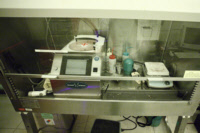Equipment
| Lab and Coral Name | TRL / PMMAspinner |
| Model | 0 |
| Specialist | Dennis Ward (Paul Tierney) |
| Physical Location | 4F External-Photo |
Classification
| Process Category | Photo |
| Subcategory | Coat |
| Material Keywords | Polyimide, Other Polymers, Photoresist, EBL Resist |
| Sample Size | 6" Wafers, 4" Wafers, Pieces |
| Alternative | TRL / coater |
| Keywords | single wafer, manual load, top side of sample, conformal dep, manual operation, spinning substrate |
Description
The PMMAspinner is a spin coater used for coating wafers or pieces with e-beam resists (HSQ, PMMA, ZEP), Polyimide, or other photo resists. The coater contains exchangable trays and therefore no cleaning is required after coating. This makes it particularly suitable for polyimide coating. Multi-step programs can be entered, and spin speed, accelleration, and spin time can be specified for each step. A red process compatible hotplate is located in the hood for pre-baking. Green processes need to use clean aluminum foil to protect the wafers from contamination when using the hotplate.
| Best for | Coating wafers with e-beam resists or polyimide, or resists that are not acetone-soluable. |
| Limitations | Static dispense only, tool is not located in regular photo room so you'll need to bring a suitable sample carrier. This also means that a pre-bake must be performed on the hotplate in the hood. |
| Characteristics/FOM | Programmable spin steps and ramp speeds, up to 5000 rpm. Maximum allowed temperature on the hotplate is 200C. |
| Caution with | Please remove the chuck after use to prevent resist residues from getting it stuck to the drive axis. Please use the right color code chuck. Green process wafers need to cover the hotplate with Al foil to avoid wafer contamination. |
| Machine Charges | 3/wafer |
Documents
SOP
| PMMA-spinner | SOP for the PMMA spinner |
| Resist Recipes | Baseline resist recipes for TRL |
Documents
| SPR700 | Datasheet for SPR700 standard resist |
| Photoresist | Application Note describing photoresist chemistry |
| Liftoff Resist | Application Note describing liftoff resists |
| Coating | Application Note describing spincoating |
| Developing Resist | Application Note describing resist development |
| PI Selection | Application Note describing polyimide choices |
| HD4100 | Datasheet for HD4100 polyimide |
| HD25XX | Datasheet for HD2525 polyimide |
| PMMA | Datasheet for PMMA e-beam resist |
| maN2400 | Datasheet for maN2400 e-beam resist |
External Links
| Guide | MicroChem Application Notes |
Process Matrix Details
Permitted
Been in the ALDSamples that have been in any of the ALD systems
, Pyrex SubstratesPyrex substrates can be a concern due to high sodium content, which contaminates CMOS frontend tools
, III-V SubstratesAny III-V substrates, e.g. GaAs, GaN, InP, and so on. Note though that many common III-V substrates will also carry the Au flag, but there are some GREEN III-V substrates.
, Germanium on surfaceSamples with germanium on the surface (typically grown films)
, Germanium buriedSamples with germanium buried below a different film
, PiecesWafer pieces may not be handled by the equipment, and are harder to thoroughly clean - preventing them from running in certain tools.
, Gold or RED color codeRED color code substrates. These are gold-contaminated or have been processed in gold contaminated tools. Gold and other metals can contaminate silicon devices (GREEN color code) and have to be separated.
, Any exposure to CMOS metalIf the sample had ever seen a CMOS metal (or a tool that accepts CMOS metal), then some frontend tools could be contaminated by this.
, CMOS metal on surfaceCMOS compatible metals exposed on the surface. These are Al,Ni,Pt,Ti,TiN. Other metals such as Au are *NOT* part of this.
, CMOS metal buriedCMOS compatible metals covered entirely by a different material. These are Al,Ni,Pt,Ti,TiN. Other metals such as Au are *NOT* part of this.
, Been in the STS DRIEThe DRIE etch leaves behind polymer residues on the sidewall ripples, which can be a contamination concern for some tools.
, Been in the SEMA sample viewed in the SEM must have used the appropriate chuck to avoid cross-contamination
, Been in the Concept1The Concep1 deposits dielectrics on GREEN wafers, however it also accepts metal and there can be cross-contamination for diffusion area
, Has PhotoresistSamples with photoresist cannot be exposed to high temperatures, which is typical in deposition tools. Outgassing can be a concern.
, Has PolyimidePolyimide is a very chemically resistant polymer, and can tolerate higher temperatures but cannot be exposed to typical PECVD deposition temperatures or diffusion furnaces. Outgassing can be a concern.
, Has Cured SU8Not fully cured SU8 residues can heavily contaminated plasma chambers or destroy other user's samples, but fully cured SU8 is permitted in certain tools.
, Coming from KOHAfter a KOH etch, the samples must receive a special clean because the K ions are highly contaminating to CMOS frontend tools
, Coming from CMPAfter a CMP, the samples must receive a special clean, because the slurry residues otherwise introduce contamination and particles.
Not Allowed
Ever been in EMLSamples from EML are never permitted to return to ICL or TRL
For more details or help, please consult PTC matrix, email ptc@mtl.mit.edu, or ask the research specialist (Dennis Ward )
